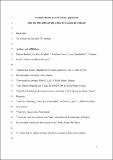Dramatic decline in a titi monkey population after the 2016-2018 sylvatic yellow fever outbreak in Brazil
Abstract
Platyrrhini are highly vulnerable to the yellowfever (YF) virus. From 2016 to 2018, the Atlantic Forest of southeast Brazilfaced its worst sylvatic YF outbreak in about a century, thought to have killedthousands of primates. It is essential to assess the impact of this epidemic onthreatened primate assemblages to design effective conservation strategies. Inthis study, we assessed the impact of the 2016-2018 YF outbreak on ageographically isolated population of Near Threatened black-fronted titi monkeys(Callicebus nigrifrons) in two Atlantic Forest patches ofthe Santuário do Caraça, MG, Brazil. Extensive pre-outbreak monitoring,conducted between 2008 and 2016, revealed that the home range and group sizes ofthe population remained stable. In 2016, the population size was estimated at53-57 individuals in 11-12 groups. We conducted monitoring and playback surveysin 2019 and found that the population had decreased by 68% in one forest patchand completely vanished in the other, resulting in a combined decline of 80%. Wediscuss this severe loss of a previously stable population and conclude that itwas highly likely caused by the YF outbreak. The remaining population is atrisk of disappearing completely because of its small size and geographic isolation.A systematic population surveys of C. nigrifrons, along other sensible Platyrrhini species, is needed to re-evaluate theircurrent conservation status.
Citation
Berthet , M , Mesbahi , G , Duvot , G , Zuberbühler , K , Cäsar , C & Bicca-Marques , J C 2021 , ' Dramatic decline in a titi monkey population after the 2016-2018 sylvatic yellow fever outbreak in Brazil ' , American Journal of Primatology , vol. 83 , no. 12 , e23335 . https://doi.org/10.1002/ajp.23335
Publication
American Journal of Primatology
Status
Peer reviewed
ISSN
0275-2565Type
Journal article
Description
The 2008-2010 data collection was financially supported by FAPEMIG-Brazil, CAPES-Brazil, the Leakey Trust and the University of St Andrews. The 2014-2016 data collection received funding from the European Research Council under the European Union’s Seventh Framework Programme (FP7/2007–2013)/ERC grant agreement no. 283871 (PI: Zuberbühler) and the University of Neuchâtel. The 2019 research was financially supported by the European Research Council (ERC) under the European Union’s Horizon 2020 research and innovation programme (grant agreement No 788077, Orisem, PI: Schlenker), from the Fyssen Foundation (post-doc grant) and from the Global Wildlife Conservation’s Primate Action Fund and the Margot Marsh Biodiversity Foundation, and the Institut d’Etudes Cognitives, Ecole Normale Supérieure - PSL Research University supported by grants ANR-10-IDEX-0001-02 and FrontCog ANR-17-EURE-0017.JCBM thanks the Brazilian National Council for Scientific and Technological Development/CNPq for a research fellowship (PQ 1C #304475/2018-1). KZ thanks the Swiss National Science Foundation 310030_185324.Collections
Items in the St Andrews Research Repository are protected by copyright, with all rights reserved, unless otherwise indicated.

